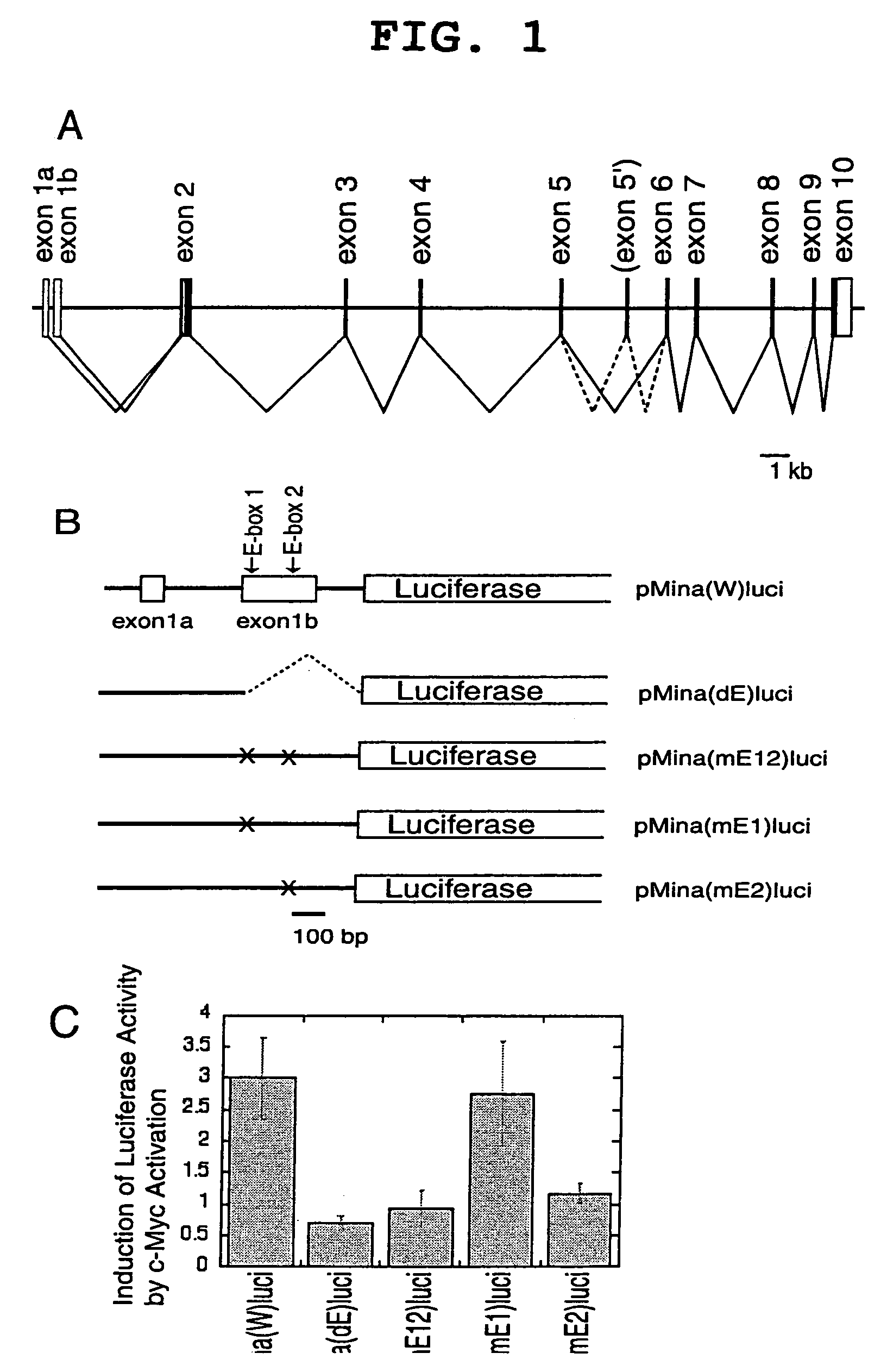Cancer associated gene mina 53, protein Mina 53 and monoclonal antibody thereof
a gene and protein technology, applied in the field of cancer associated gene mina53, can solve the problems of insufficiently clarifying the mechanism of demonstrating myc functions, accumulating irregular genes, and induguing normal cells to become cancerous, and achieve the effect of inhibiting the proliferation of cancer cells
- Summary
- Abstract
- Description
- Claims
- Application Information
AI Technical Summary
Benefits of technology
Problems solved by technology
Method used
Image
Examples
example 1
Plasmids Encoding c-Myc
[0093]Pc-myc / CDM8 (Tsuneoka, M. et al. (1997) Oncogene 14, 2301-2311), in which human c-myc is driven by a CMV promoter, was used. This plasmid was digested with PstI and self-ligated to produce pc-myc (d41-178) / CDM8, which encodes a mutant c-Myc protein lacking the transcriptional activation domain. The 2-kb BstXI-KpnI fragment, blunted with Klenow enzyme, of pTc-mycer / BS was inserted into a 5-kb EcoRI fragment, blunted with Klenow enzyme, and de-phosphorylated with E. coli alkaline phosphatase of a pCAGGS mammalian expression vector to produce pc-mycer / CAGGS in which c-mycer is driven by a chimeric promoter consisting of chicken actin and CMV promoters.
example 2
Plasmids Encoding Mina53
[0094]cDNA for human mina53 was amplified by PCR with 5′-GAAGCTTATGCCAAAGAAAGCAAAGCCTACAGG-3′ (SEQ ID NO: 4), adding a HindIII site just before the initiation codon methionine, and 5′-TGAATTCATCCTCTCCTCGGCTCAGGTCTT-3′ (SEQ ID NO: 5), as primers from a library of human erythroid leukemia (HEL) cells, and the amplified 1.4-kb fragment was cloned into a pGEM-T-vector (Promega) to produce pT / hmina53 (465) and pT / hmina53 (464), encoding 465- and 464-amino acid proteins, respectively. The 1.4-kb HindIII-SalI fragment of pT / hmina53 (465) was extended and cloned using pGEFP-CS (Clonetech) cut with HindIII and SalI to produce pEGFP / hmina53 (465). The 1.4-kb HindIII-NotI fragment of pT / hmina53 (465) digested with HindIII and NotI was inserted into pRc / CMV (Invitrogen) to produce pmina53 / Rc / CMV. The DNA fragment encoding human mina53 was amplified by PCR with 5′-GCCATGCCATGGCAAAGAAAGCAAAGCCTAC-3′ (SEQ ID NO: 6), adding NcoI site, and 5′-GGCATGCCATGGCTAGACTACTTGAATTAAAC-...
example 3
Reporter Plasmids Having a Mina53 Genomic DNA Fragment
[0095]A genomic DNA fragment of the human mina53 gene, which extends from the promoter region to part of intron 1, was amplified by PCR with 5′-CGGGATCCTGAACGCGGAACACCGCCGGGTAGC-3′ (SEQ ID NO: 8), adding a BamHI site, and 5′-CCCAAGCTTCCTCTTCCTCCCAGTCTATCCTTC-3′ (SEQ ID NO: 9), adding a HindIII site as primers using human peripheral blood derived DNA as a template. The 0.8-kb amplified fragment was cleaved with BamHI and HindIII and inserted into the 4.8-kb fragment of pGL3 (Promega) cut with BglII and HindIII followed by cutting with BamHI and HindIII to produce pMina(W)luci. pMina(W)luci was cleaved with HindIII and PmaCI, blunted with Klenow enzyme, and self-ligated to produce pMina(dE)luci. Mutation was introduced at E-box sites of pMina(W)luci using a Gene Editor™ in vitro site-directed mutagenesis system (Promega) to produce pMina(mE1)luci, pMina(mE2)luci, and pMina(mE1 / 2)luci, in which one or two E-boxes (CACGTG elements) w...
PUM
| Property | Measurement | Unit |
|---|---|---|
| molecular weight | aaaaa | aaaaa |
| temperature | aaaaa | aaaaa |
| temperature | aaaaa | aaaaa |
Abstract
Description
Claims
Application Information
 Login to View More
Login to View More - R&D
- Intellectual Property
- Life Sciences
- Materials
- Tech Scout
- Unparalleled Data Quality
- Higher Quality Content
- 60% Fewer Hallucinations
Browse by: Latest US Patents, China's latest patents, Technical Efficacy Thesaurus, Application Domain, Technology Topic, Popular Technical Reports.
© 2025 PatSnap. All rights reserved.Legal|Privacy policy|Modern Slavery Act Transparency Statement|Sitemap|About US| Contact US: help@patsnap.com



